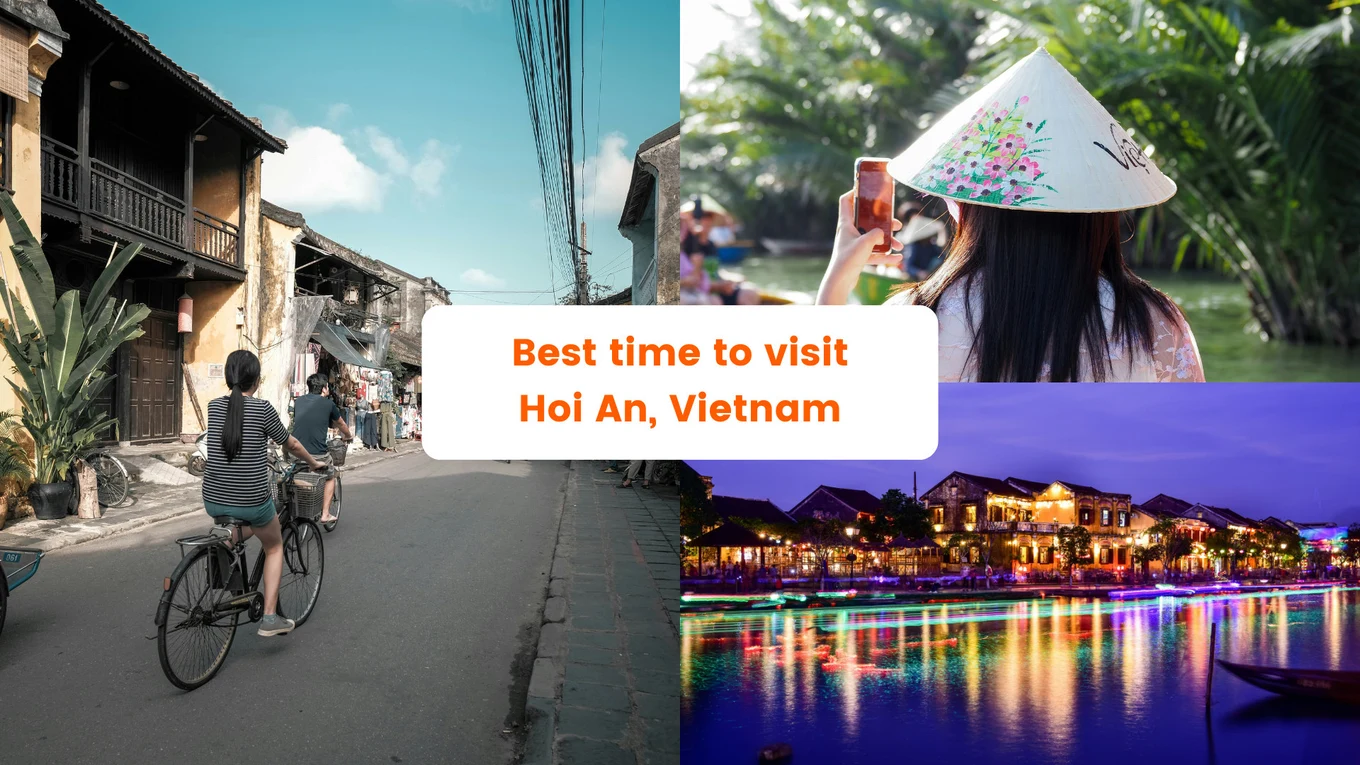A seasonal guide for travellers heading to Hoi An 🇻🇳
Step back in time and explore the enchanting ancient town of Hoi An. This captivating destination in Vietnam beckons travellers with its vibrant blend of history, culture, and natural beauty, but when exactly is the ideal time to immerse yourself in its magic?
The weather, crowds, and festivals here can all impact your travel experience, so we've prepared this comprehensive guide that explores the best time to visit Hoi An, considering these factors and offerings tips on what to wear and pack. Let's dive into the details to discover the perfect season for your ideal Hoi An adventure!
🔥 Top tours & activities in Hoi An 🔥
Enjoy hassle-free travel by booking these best-selling tours and activities!
Transportation essentials:
Day tours:
Attractions:
Best time to visit Hoi An
The best time to visit Hoi An is from February to April. During these months is the dry season, where you can expect minimal rainfall, moderate temperatures, and a cooling but sunny weather. This is the most popular time to visit Hoi An as the weather sets the perfect conditions for sightseeing, leisurely strolls, and beach activities.
Various festivals also take place during this season, where visitors can immerse themselves in the vibrant atmosphere of the Lunar New Year celebrations and the colourful Hoi An Lantern Festival. These months are particularly enchanting as the streets of the old quarter come alive with festive lights and traditional performances.
However, do take note that this is also the most crowded and expensive time to visit Hoi An. Prices for flights and hotels will be at their highest, and the beaches and tourist attractions can be quite crowded. As an alternative, January is also a good time to visit, offering even colder conditions with less crowded streets, ideal for peaceful exploration and photography.
Weather throughout the year
Hoi An’s climate is influenced by the tropical monsoon, resulting in a distinct dry season from February to August and a wet season from September to January. The average annual temperature hovers around 25.6°C, with the hottest months being June to August, where temperatures can soar up to 39.8°C.
During the dry season, from February to April, the weather is characterised by mild temperatures, light sunshine, and minimal rain. This period is ideal for outdoor activities such as exploring the ancient town, visiting nearby beaches, and enjoying the countryside. As May approaches, temperatures begin to rise, and light showers become more frequent, yet the weather remains pleasant enough for exploration.
The wet season, from September to January, brings heavy rains, typhoons, and occasional floods to Hoi An. Despite the wetter conditions, the cooler temperatures ranging from 19 to 24°C make it a more comfortable experience for some. While November to January sees fewer showers, allowing for more outdoor activities and exploration of the UNESCO World Heritage site, the overall atmosphere during the wet season is cooler and more refreshing compared to the hot and muggy dry season.
Dressing for the weather
Dressing appropriately for Hoi An’s weather is crucial to ensuring a comfortable and enjoyable visit. During the dry season, we recommend wearing lightweight and breathable clothing to stay cool under the warm sun. Don’t forget to pack a hat, sunglasses, and sunscreen to protect yourself from the strong sunlight while exploring the town on foot or by bicycle.
In the wet season, waterproof gear becomes essential. We recommend considering to bring these a couple of these items if you are able to – a good raincoat or waterproof jacket, an umbrella, quick-drying clothes, and waterproof footwear. With these items, you can stay dry and still enjoy outdoor activities during sudden downpours.
When visiting Hoi An, it’s also important to respect local customs. Modest clothing that covers shoulders and knees is appreciated, especially when visiting temples and other cultural sites. We suggest layering your outfit, as it allows you to adjust to the varying temperatures and conditions throughout the day.
Peak tourist season vs. Off-peak season
During the peak tourist season, typically from February to April, Hoi An experiences a higher influx of tourists due to the comfortable weather and ongoing festivals, making popular attractions more crowded. The increased number of visitors often leads to higher accommodation prices and longer waits at popular spots.
In contrast, visiting Hoi An during the off-peak season offers a more tranquil experience with reduced crowds and lower prices. The low season, from May to July, though warmer and wetter, allows for a different side of Hoi An to be appreciated. The town is quieter, and the tropical rains bring a unique charm to the ancient streets.
Planning your visit by the season
Dry season
The dry season in Hoi An is perfect for outdoor exploration, beach activities, and leisurely walks through the old town or countryside. From May to August, the town enjoys warm sunshine and very little rain, making it an ideal time for beach visits. Cua Dai Beach and An Bang Beach are popular spots where visitors can soak up the sun and enjoy the clear blue waters without worrying about rain.
Clear skies and pleasant weather create the perfect conditions for exploring the ancient town and its beautiful surroundings. Whether you’re wandering through the historic streets, visiting local markets, or cycling through rice paddies, the dry season offers endless opportunities for adventure.
Rainy season
The rainy season in Hoi An offers a unique charm, with a cooler atmosphere and fewer crowds. From September to January, the town faces heavy rains, typhoons, and occasional floods. Despite these challenges, the fresh and cooler air creates a pleasant environment compared to the hot and muggy dry season.
One of the benefits of visiting the ancient town Hoi An during the rainy season is the peaceful atmosphere. With fewer tourists around, you can enjoy a more serene experience in the ancient town. The rain enhances the mossy, ancient appearance of architectural sites like the Japanese covered bridge Bridge Pagoda and Ong Pagoda, giving them a timeless beauty. Additionally, the Thu Bon River adds to the charm of the town, creating a picturesque backdrop. As you stroll along Tran Phu Street, you’ll truly appreciate the tranquility of this enchanting destination.
Key festivals and events in Hoi An
1. Vietnamese New Year
Tết, or Vietnamese New Year, is the most important festival, marked by ceremonies, traditions, and gift-giving. Following the Vietnamese calendar, it marks the beginning of spring in the North of Vietnam, as well as the first day of the Lunar New Year.
2. Hoi An Lantern Festival
Lantern Festival, also known as the Full Moon Festival takes place during the full moon, featuring lanterns lit and floated on the river as offerings to ancestors. This festival happens monthly on the 14th day of the lunar month, when the moon is at its fullest and brightest.
3. Mid-Autumn Festival
The Mid-Autumn Festival, celebrated in September, includes lantern parades and moon cakes, marking the end of the rice harvest.
Other events
In addition to these major festivals, Hoi An’s coastal villages in Quang Nam Province celebrate fish festivals with sacrifices and traditional games in the second lunar month. The Hoi An Boat Racing Festival, held on the 2nd day of the first lunar month, features exciting boat races with vessels adorned with dragon heads. Hoi An also hosts the International Choir Competition biannually, with the next event scheduled for April 2025.
Tips for planning your visit
Hoi An offers a wide range of accommodations, from boutique hotels and villas to budget-friendly options, with prices ranging from as low as $12 per night for budget options to over $100 for luxurious stays. Many hotels provide free WiFi and breakfast, ensuring a comfortable stay. Free bicycles are often available at many accommodations, allowing guests to explore the area conveniently.
Transportation options to get from Da Nang to Hoi An include taking the train, a bus, a taxi, or a motorbike. The price for a taxi ride from Da Nang to Hoi An Old Town ranges from 200,000 VND to 250,000 VND, and renting a motorbike costs approximately 120,000 - 150,000 VND per day.
Additional amenities and services in Hoi An include various dining options, shopping opportunities, and local tours. Exploring the ancient town on foot is a must-do, as it allows you to fully appreciate the historic architecture and vibrant street life.
🔥 Top tours & activities in Hoi An 🔥
Enjoy hassle-free travel by booking these best-selling tours and activities!
Transportation essentials:
Day tours:
Attractions:
What is Klook?
Klook is Asia’s leading platform for experiences and travel services. We curate quality experiences ranging from attractions and tours to local transport and experiential stays, in over 2,700 destinations globally.
Browse our growing collection of travel activities and services in 15 languages, and complete bookings seamlessly with 40 currencies and over 40 payment methods.
Founded in 2014, we are here to inspire and enable more moments of joy for travelers anytime, anywhere. Whether it's something new in your neighborhood or an adventure abroad, with Klook you're always connected to a world of things to do and places to see.





























